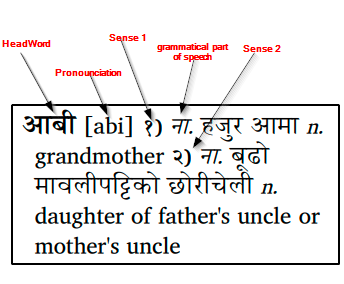Entry Explained
A simple entry has three parts. First is the Lhomi headword. This begins each entry and is shown in bold type. Second is the grammatical part of speech which is shown in an abbreviated form in italic type. (See the List of Abbreviations where these are expanded). Third is the definition which shows the meaning of the Lhomi headword in English. In many of the definitions there are a number of equivalent English words that can be used to describe the Lhomi meaning. These are listed separated by commas ending with a semicolon. Sometimes, after the semicolon a further explaining phrase is given that serves to expand the definition.
 In the example given below, The Lhomi word, ‘abi’, has multiple meanings. However, words have single meaning also. These multiple meanings are called senses and they are indicated in the dictionary by sense numbers. Each sense begins with a number followed by a closed bracket. The various senses in an entry have distinct meanings, but they are all related in some way. That is why they are given numbers and listed under a single Lhomi headword.
In the example given below, The Lhomi word, ‘abi’, has multiple meanings. However, words have single meaning also. These multiple meanings are called senses and they are indicated in the dictionary by sense numbers. Each sense begins with a number followed by a closed bracket. The various senses in an entry have distinct meanings, but they are all related in some way. That is why they are given numbers and listed under a single Lhomi headword.
See https://lugungu.webonary.work/dictionary-entries-explained/ for an example
